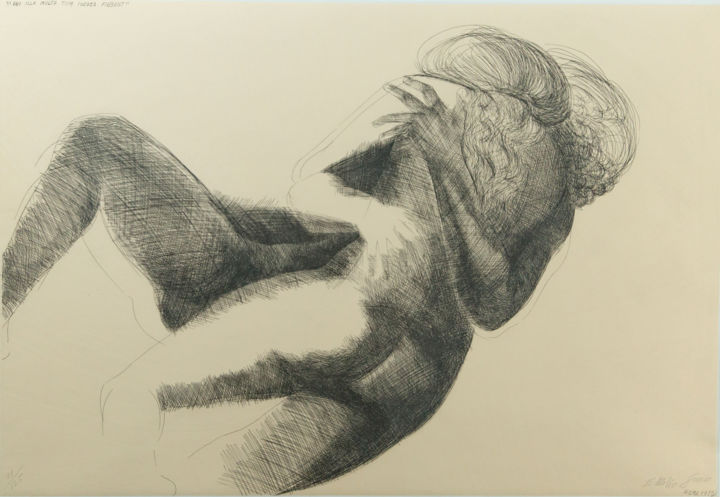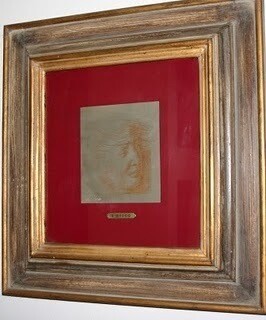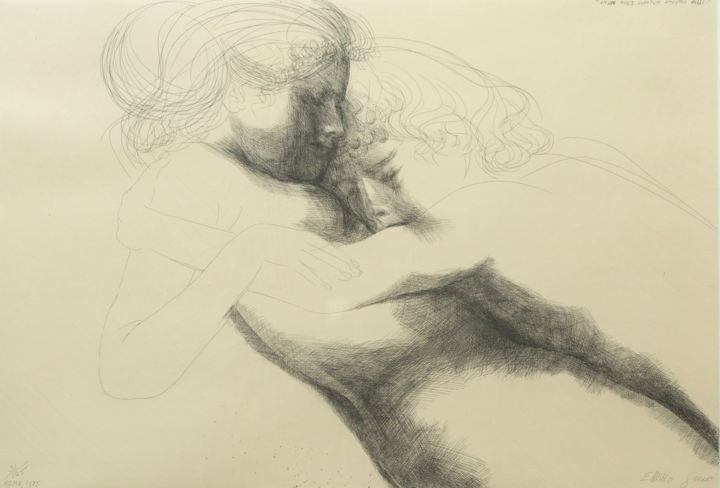Emilio Greco was a distinguished sculptor and illustrator, renowned for his ability to capture the essence of humanity through fluid and dynamic forms. His works, which span sculptures, drawings, and engravings, are celebrated for their emotive power and refined elegance.
Master's Journey
Born on October 11, 1913, in Catania, Sicily, he demonstrated a keen passion for creativity from an early age, filling his notebooks with drawings despite his father's initial disapproval. At the age of 13, he began working as an apprentice to a stonemason, an experience that proved crucial for his artistic development. He later studied at the Academy of Fine Arts in Palermo.
After World War II, his professional career gained momentum with his first solo exhibition held in the Italian capital in 1946. Subsequently, he taught three-dimensional art at various prestigious institutions, including the Academy of Fine Arts in Rome and the Academy of Munich. His dedication to teaching and his craft profoundly influenced many students and emerging talents.
He continued to exhibit his creations internationally, earning recognition and awards for his contributions to contemporary expression. His unique style and technical skill garnered admiration from critics and peers, solidifying his reputation in the global scene.
In addition to his career as a creator, he participated in numerous public projects and collaborations with other creatives, further expanding his influence in the creative field. His pieces are now displayed in important institutions and private collections, testifying to his lasting cultural impact.
His bond with Sicily remained strong throughout his life, often drawing inspiration from the traditions and landscapes of his homeland. This connection was reflected in the emotional depth and expressive richness of his creation.
He passed away on April 5, 1995, in Rome, leaving behind a legacy of extraordinary contributions. His life and endeavors continue to be studied and celebrated, representing an example of dedication and passion for creativity that inspires new generations of creators.
The Style and Iconic Creations
The master's creation is often associated with the Mannerist tradition, characterized by refined and elongated forms. His style blends elements of classical and modern art, focusing on themes such as the human figure, particularly female nudes, and portraits. His production reflect a deep sense of realism infused with a poetic touch, often exploring themes of beauty, grace, and spirituality.
Among Greco's most notable pieces are:
- Monument to Pope John XXIII: Located in St. Peter's Basilica, Vatican City, this creation honors the beloved "Good Pope" with a depiction full of humanity and reverence.
- The Bathers: A series of sculptures that celebrate the beauty of the female form in serene, natural poses.
- Monument to Pinocchio: Situated in Collodi, Tuscany, this playful and dynamic piece captures the spirit of the famous puppet.
- Doors of the Cathedral of Orvieto: These bronze doors, completed between 1961 and 1964, showcase Greco's mastery in large-scale religious art.
 RITRATTO DI EMMA (1971) Printmaking by Emilio Greco
RITRATTO DI EMMA (1971) Printmaking by Emilio Greco
Analysis of some pieces
Analysis and Description of "Ritratto di Emma"
"Ritratto di Emma" (Portrait of Emma) from 1971 is an exemplary piece by the renowned artist. This print captures the delicate and nuanced features of a young girl named Emma, likely one of his students at the Art Institute of Rome.
The master is known for his ability to blend classical artistry with personal sensibilities, and this piece is a prime example. The portrait features distinctive circular swirls of fine lines, adding movement and fluidity, which enhance the lifelike quality of Emma's hair and face. These intricate, swirling lines create a textured, almost ethereal quality, defining the form of Emma's hair and adding dynamic energy to the piece.
The artist employs a combination of light and dark shading to sculpt the contours of Emma's face. Intricate cross-hatching around her cheeks and subtle shadows around her eyes and mouth add depth and dimension, highlighting her delicate features. Emma's serene and introspective expression is beautifully captured, with closed eyes and a gentle smile suggesting a moment of quiet reflection or inner peace. The slightly tilted head and naturally flowing hair create a sense of softness and grace.
Emma is portrayed with sensitivity and delicacy, reflecting his keen eye for capturing the human spirit. Her youthful innocence is juxtaposed with a certain maturity in her expression, showcasing the artist's skill in depicting complex emotional states. As an educator at the Art Institute of Rome, he often drew inspiration from his surroundings and students, which is evident in the personalized and intimate nature of this portrait.
"Ritratto di Emma" stands as a testament to Emilio's prowess in drawing and portraiture. His technique of using fine lines and swirling patterns has influenced many contemporary creators, who seek to capture the same blend of realism and expressionism in their creations. This piece remains a significant part of his artistic legacy, admired for its emotional depth, technical precision, and timeless beauty.
 BEATRICE (1977) Printmaking by Emilio Greco
BEATRICE (1977) Printmaking by Emilio Greco
Analysis and Description of "Beatrice"
"Beatrice" (1977) is a printmaking piece that exemplifies his refined graphic style. This portrait is part of a series dedicated to prominent women in Italian literature, paying homage to Beatrice, Dante Alighieri's beloved muse.
The master is celebrated for his ability to convey profound emotion and delicate beauty through detailed line creation. This piece uses a combination of intricate, swirling lines and subtle shading to create depth and texture. The fine lines define Beatrice's face and hair, imbuing the portrait with movement and life. Subtle cross-hatching adds dimension, highlighting her delicate features and producing a realistic effect.
The composition depicts Beatrice with a serene, contemplative expression, enhancing the tranquil mood. This portrayal captures her ethereal nature, symbolizing purity and divine love.
"Beatrice" is part of a series that honors iconic women from literature, reflecting his appreciation for literary history and his ability to draw inspiration from it. This piece showcases his exceptional talent in printmaking and portraiture, blending classical themes with personal techniques. His creations continue to be admired for their emotional depth, technical precision, and timeless beauty.
 AMATA NOBIS QUANTUM AMABITUR NULLA (1975) Incisioni, stampe da Emilio Greco
AMATA NOBIS QUANTUM AMABITUR NULLA (1975) Incisioni, stampe da Emilio Greco
Analysis and Description of "Amata Nobis Quantum Amabitur Nulla"
"Amata Nobis Quantum Amabitur Nulla" (1975) is an etching crafted on a copper plate with dimensions of 60x80 cm, part of a limited edition of 125 prints. The artist is renowned for his ability to express deep emotions and delicate nuances through meticulous line and shading. This piece exemplifies his skill in etching, featuring intricate swirling lines that create movement and fluidity, defining the contours of the embracing figures. The use of cross-hatching adds depth, enhancing the lifelike quality and tenderness of the embrace. The composition focuses on the upper bodies, conveying a profound sense of love and unity. The title, translating to "Loved by us as no one will ever be loved," sets a powerful tone, emphasizing themes of affection and emotional connection. This etching is part of master's broader exploration of human relationships, reflecting his deep understanding of love, beauty, and spirituality. His mastery in conveying profound emotions through his creativity continues to inspire and resonate with many contemporary artists.
Exhibitions and the Art Market
Emilio Greco, a renowned Italian sculptor, participated in prestigious exhibitions such as the Venice Biennale. His sculptures are highly valued in the art market, often fetching significant prices at international auctions. Greco's works are included in important museum collections and exhibitions worldwide, reflecting his status as one of the leading sculptors of the 20th century.
Inspiring Generations
Emilio Greco, renowned for his talent in sculpture and engraving, had a significant impact on the Italian art scene of the 20th century. His ability to merge realism with expressive form has inspired several contemporary artists, who may have drawn influence from his vision and techniques.
Giuseppe Spagnulo, an Italian contemporary sculptor known for his innovative exploration of material and form, might have found a model in Greco's approach to sculpture. Spagnulo’s work, which often delves into the use of human figures and volumes, reflects Greco’s sensitivity to expressiveness and texture. Greco’s method of manipulating materials to evoke emotions could have influenced how Spagnulo shapes his sculptures.
Sergio Fermariello, an artist specializing in sculpture and monumental art, may also have been influenced by Greco’s attention to detail and expression in the human figure. Fermariello's work, which combines realism with a strong expressive component, could reflect Greco’s technique of using lines and forms to convey deep and significant feelings.
Franco Assetto, though better known for his abstract sculptures, might still show traces of Greco’s influence in his exploration of forms and their expressiveness. While Assetto’s work diverges into abstraction, Greco’s focus on the human figure and its expressiveness could have laid a foundation upon which Assetto built his own exploration of form and abstraction.
Overall, Emilio Greco provided a distinctive approach to sculpture and engraving, emphasizing the interaction between form and emotion. While the specific influence of Greco on these contemporary artists might not be well-documented, it is plausible that his emphasis on the human figure and its expressiveness left an imprint on their work, contributing to their approach to sculpture and art in general.
Surprising Facts
- Literary Pursuits: Besides his visual art, he was an accomplished writer and poet. His collection of short stories and verse, "Lo Jonio Corrusco Di Vento," includes his own illustrations.
- Awards and Recognitions: the master received numerous accolades, including the Gold Medal for Meritorious Culture and Art from the President of Italy.
- Teaching and Influence: he was a dedicated educator, teaching at institutions in Rome, Naples, Munich, and Salzburg, influencing generations of creatives.
Emilio stands out as a beacon of color and joy in the contemporary art landscape. His biography is a testament to talent and determination, demonstrating how his distinctive style and famous pieces continue to inspire and influence creators and art enthusiasts worldwide. Through his exceptional talent, the master spreads a message of hope and positivity, ensuring his lasting legacy. His journey from Catania to global acclaim, influential connections, and philanthropic efforts all contribute to his multifaceted persona, making him a significant and intriguing figure in contemporary culture.


 Selena Mattei
Selena Mattei






